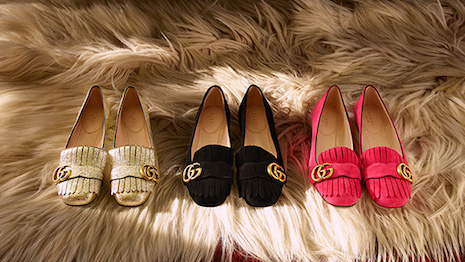- About
- Subscribe Now
- New York,
December 20, 2017

 Gucci is one of the most prolific users of email, juxtaposing arresting imagery with colorful product. Image credit: Gucci
Gucci is one of the most prolific users of email, juxtaposing arresting imagery with colorful product. Image credit: Gucci
Luxury brands are leaving potential conversions on the table by not embracing email marketing campaigns, which can see significant returns despite its outdated perception.
While there are many trending forms of marketing to catch the eye of marketers today, email campaigns are still an effective method to build relationships and track results. According to an email marketing report by Fashionbi, luxury brands are largely absent from this type of branded communication, which is likely due to their reliance on heritage as a marketing device.
"Email marketing is still one of the most common ways to keep the connection between the brand and the customer," said Yana Bushmeleva, chief operating officer at Fashionbi. "Depending on the strategy the company can send from two to emails per week till 17 to 20 emails per week.
”The most active are the online stores, for example Neiman Marcus sends 17 emails per week or Nordstrom with 15 emails per week."
Email relevancy continues
Gucci was revealed to be the most frequent user of email campaigns in Fashionbi’s Email Marketing report. The Kering-owned fashion label sends out approximately two emails per week.
In Fashionbi’s study, luxury marketers were the brands who sent the least number of emails, while multi-brand retailers sent the highest number.
Luxury brands were reported to have sent an average of .62 emails per week. Premium brands, such as Michael Kors, sent an average of 1.73 emails a week and fast-fashion brands published 2.84 email campaigns weekly.
Multi-branded retailer Web sites sent an average of 4.28 emails per week.
Fashion houses Helmut Lang and Christian Dior were the least frequent emailers out of the luxury group. The two sent out an estimated .07 and .37 emails a week, respectively.
Amongst premium brands, Michael Kors leveraged the greatest number of email campaigns, sending an approximate seven emails per week.
Opening Ceremony followed Michael Kors at about six emails sent a week. Neiman Marcus was named as the brand with the highest number of email campaigns, at more than 17 emails per week.
While there may be a preconceived notion that email marketing is outdated, compared to the shiny new tactics of today, an email strategy is tried-and-true. If done correctly, email campaigns offer a clear path of measurement and build a relationship with subscribers.
For every $1 spent on an email campaign, brands saw a return of $44 in sales.
Automated emails are being used by brands to create more relevant and personal messaging based on purchasing habits. For instance, those who send automated campaigns through email are 133 percent more likely to send applicable content that relates to a customer’s purchase cycle.
Effective strategies
Email marketing is still a viable tool in most marketers’ toolsets, but shorter subject lines are key to making them effective.
According to other research from Yes Lifecycle, marketing emails with subject lines fewer than 21 characters generated a 31 percent higher open rate. Unfortunately, only 5 percent of all email subject lines from marketers met this criteria (see more).
While standard email campaigns have become stale, kinetic email marketing optimized for mobile devices and with interactive elements can also enhance click rates by almost 20 percent, according to a report from Experian.
The report looked at the difference between static emails and more kinetic, interactive email marketing to gauge how much more effective the latter is than the former. The data found that kinetic emails performed significantly better than static in terms click rates and engagements from consumers (see more).
“In the majority of cases, these newsletters are impersonal, very often the brand has a pop-up window on the website with a call to action to sign up for the newsletter just by typing the email address, without asking your name or products of interest (e.g. womenswear vs menswear),” Ms. Bushmeleva said. “As the result potential customer ignoring or deleting these emails.
“Some brands send the newsletters with the images which do not have a link embedded in them - this is another rude mistake,” she said. “Overall the effectiveness of email marketing strategy should be periodically measured by using a set of Key Performance Indicators and tweaked based on the results.”
Share your thoughts. Click here